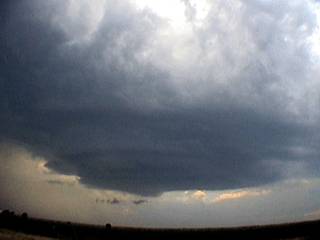Anti-mesocyclone Supercell
Good day,
It is quite possible for a LEFT moving supercell to split away from the southern (right moving) split and become the main supercell, but not always. Usually the right split becomes the main "show".
A rather interesting example of an "anti-supercell", or a supercell that roatates CLOCKWISE, occurred on May 26, 2004 near Altus, Oklahoma and a picture of the storm is shown below...
You may see that this picture resembles an "Australian supercell" or "mirror image" but it's not, despite its impressive structure too. The view is to the west and clearly you can see that the inflow region is to the RIGHT, and precipitation to the LEFT (a mirror image or a "regular" supercell). Inflow was from the northeast into the storm on the NE side of it, which bent to a north wind, then flowed westward into the "notch" and vault of the storm (between the precip and RF base, to the LEFT, not the RIGHT in this picture). Note even the updraft is "leaning" more to the left with height, so bulk / storm-relative shear may even be reversed (stronger wind at surface than aloft) due to the fast NNE motion of the cell.
If you look closely, the RFD can even be seen cutting under the updraft from the left, then towards the photographer in the lower center of the updraft, that is clockwise. Also note the scud, hinting wall cloud development, is also angled towards the precipitation to the left, opposite of what we are used to seeing with a cyclonic supercell.
Only 1 to 2 percent of supercell storms are anticyclonic (in the southern hemisphere, the opposite applies, where counter clockwise supercells are rare opposed to clockwise ones). This is due to normal verring / backing patterns of winds aloft. In the USA, a southeast surface winds veers southwest aloft, encouraging a counter clockwise spin on MOST supercells. In Australia, a northeast wind at the surface gives way to a northwest wind aloft, hence "backing" winds with height, so MOST supercells normally rotate clockwise there. The coriolis force does not affect mesoscale rotations too much if at all. Aside from this, boundary interactions and / or deviant motion can cause such "opposite" turning supercell rareties.
Conditions (hodographs) this day favored splitting storms, and this one was anchored along a boundary that was moving rapidly northward. The southern split dissapated quickly, and was moving southeast at about 10-15 MPH. This left split here, was moving NNE at nearly 60 MPH! The main speed vector was ENE at about 20-25 MPH that day based on SPC text and hodographs.
A supercell storm moving NNE at that speed and so deviant from the main "steering" flow will experience totally the opposite storm-relative helicity a right-moving supercell would "feel". With such high "negative" helicities the low level meso would rotate anticyclonically.
The example above did produce a small funnel, clockwise rotating, but that's about it. Much attention was owed to the "stacked plate" structure despite it rotating clockwise.
Another note, do NOT try to go south of this storm to check the "right split" as the WORST hail (reported baseball sized with this particular storm) was SOUTH of the updraft, and not NORTH of it ;-)
Chris C - KG4PJN

